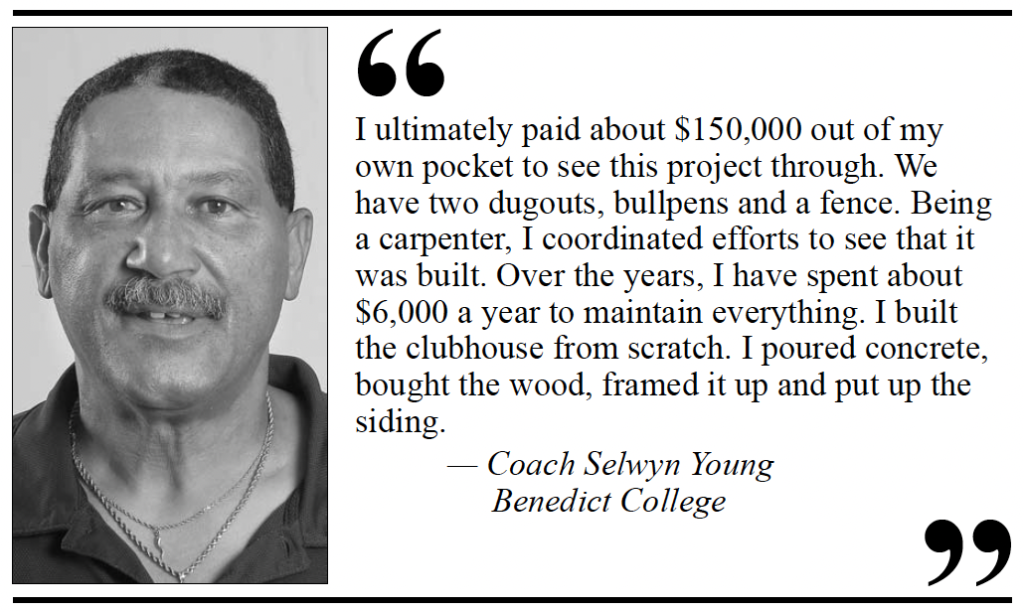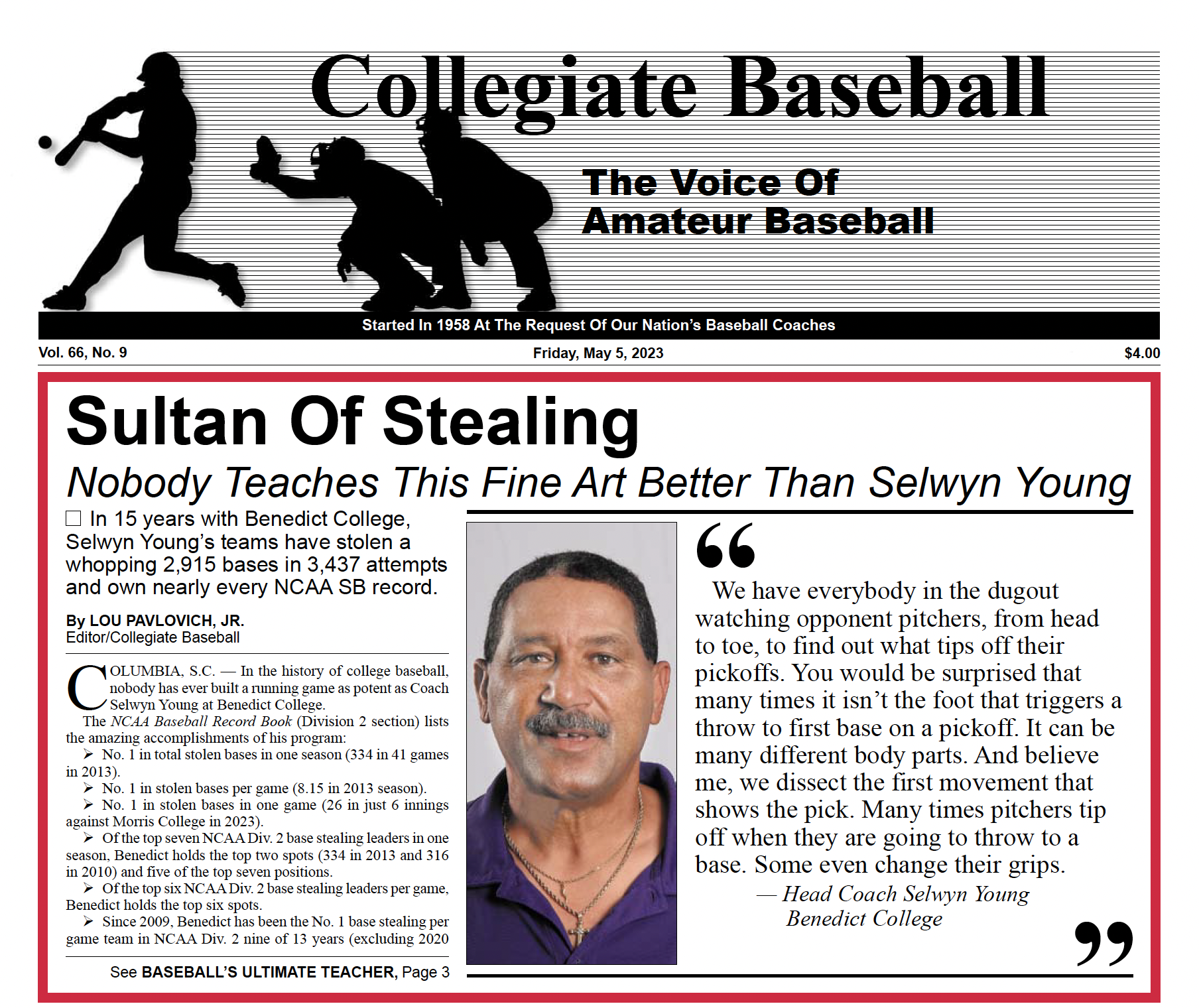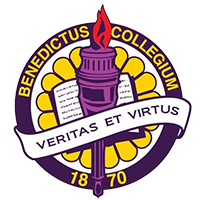In 15 years with Benedict College, Selwyn Young’s teams have stolen a whopping 2,915 bases in 3, 437 attempts and own nearly every NCAA SB record.
By Lou Pavlovich, Jr., Editor, Collegiate Baseball
COLUMBIA, S.C. — In the history of college baseball, nobody has ever built a running game as potent as Coach Selwyn Young at Benedict College.
The NCAA Baseball Record Book (Division 2 section) lists the amazing accomplishments of his program:
- 1 in total stolen bases in one season (334 in 41 games in 2013).
- 1 in stolen bases per game (8.15 in 2013 season).
- 1 in stolen bases in one game (26 in just 6 innings against Morris College in 2023).
- Of the top seven NCAA Div. 2 base stealing leaders in one season, Benedict holds the top two spots (334 in 2013 and 316 in 2010) and five of the top seven positions.
- Of the top six NCAA Div. 2 base stealing leaders per game, Benedict holds the top six spots.
- Since 2009, Benedict has been the No. 1 base stealing per game team in NCAA Div. 2 nine of 13 years (excluding 2020 due to COVID-19 pandemic).
- Since this dynamic coach has been with the program, Benedict has stolen 26, 24, 18, 17 (twice), 16, 15, 14 and 13 bases in games.
- In 15 years with the program, Young’s teams have stolen 2,915 bases in 3,437 attempts for an 85 percent success rate.
- Since 2009 (excluding the COVID-19 pandemic years of 2020 and 2021 since his teams only played 11 and 8 games), his teams have averaged 224 stolen bases over 13 seasons.
- Two of his teams have swiped over 300 bases in one season.
- This season Benedict has stolen 160 of 182 bases in 26 games. Nineteen different players have stolen bases.
We haven’t even mentioned the numerous Benedict players who are listed in the NCAA Baseball Record Book.
It is a massive understatement to say his system works with his high octane brand of baseball.
He may be the greatest teacher of base stealing in history on any level.
Young played his college ball at Pepperdine University under Dave Gorrie in the late 70s and learned the game in the greater Los Angeles area as he studied base-stealing legend Maury Wills of the Los Angeles Dodgers, among others.
Young said that over the 15 years he has been with Benedict College, his base stealers are safe 85 percent of the time.
“We don’t just run at every opportunity,” said Young.
“We have smart players who run on specific counts that we are fairly sure opponents will throw off-speed pitches on.
“We chart opponent pitchers to find out what they do in every count to find out if they have tendencies.
And you would be surprised how predictable teams are in different counts.”
Unique Pitch Count Chart
Young said his kids keep a special chart to track every pitch count.
“Along the top is 0-1-2-3 and along the side is 0-1-2-3. We then have our kids mark H for hard pitch on every count or S for soft pitch. If the pitcher tendency on a 0-0 count is a fastball or hard slider, there will be a bunch of H marks in that category.
“If there are certain counts which show a high percentage of soft pitches (curves, changeups, etc.), then those are great counts to steal on.
“Base stealing is a thinking man’s game, and we explore every avenue to make our attempts a high percentage move. This is my 50th year in baseball counting the time I played in high school, college, and pro ball. When you have been involved in the game that long, you pick up a bunch of things over time.”
Young said that his players are all world-class readers of pickoff moves.
“We have everybody in the dugout watching opponent pitchers, from head to toe, to find out what tips off their pickoffs. You would be surprised that many times it isn’t the foot that triggers a throw to first base on a pickoff. It can be many different body parts. And believe me, we dissect the first movement that shows the pick. Many times pitchers tip off when they are going to throw to a base. Some even change their grips.”
Young said many opposing pitchers use the slide step to deliver pitches quicker to home.
“They have tried everything to stop us because they know we are going to run no matter what.
“Pitchers have held balls for long counts, threw over to first numerous times, stepped off…you name it.
“We try to be smart about the tactics other teams utilize against us. With our philosophy, the focus is mainly on the pitcher.
“Almost everything we do is based on what the pitcher does and the count which makes what the catcher does less important. If a catcher is not skilled, that obviously helps us as well.”
Young said that he recruits speed and has a number of fast runners. But speed isn’t everything.
“They have to be taught all the little things to be successful base stealers. That is why I teach a base stealing class which helps the players understand what is expected.
“We also do a lot of form running with distance running and sprints. They do stride drills and different running drills to strengthen their legs.
“There is 90 feet between the bases.
“If you have a guy with a five foot lead, it should take him 12 steps to get to second base. If he leaves at the proper time, he will almost always be safe.
“Usually you take 10 steps and then slide.”
System Tough To Stop
Young, who coached with the Santa Barbara Foresters for six years and led the 2001 ball club to 257 stolen bases, a National Baseball Congress record, said that his system is extremely difficult to stop.
“Guys who come into our program can be fast runners. But we still have to work on their stride length and form and make sure they run in straight lines from one base to the other.
“That sounds rather simple, but some runners stray to the left or right.”
Young also played in the Oakland A’s system when he played pro ball in the minor leagues and was introduced to Billy Martin’s system of small ball and running. His teams in the minor leagues won three championships with this system.
His players not only steal second regularly. But they steal third with a certain philosophy in place and have been successful stealing home.
“When one of our runners is on second, he takes seven steps toward third and makes a mark. Then he goes out to 11 steps and makes another mark. The goal is to work your way out to the 11-foot mark and take off for third. You can walk or crow hop. But it is vital to watch the front shoulder of the pitcher to determine if he is going home or is picking at second.
“We have been very successful in stealing third with this strategy.”
Young said that stealing home is challenging but can be accomplished.
“With a runner at third, I will go down the line with him to see if the pitcher is paying attention at all to him. If I feel my guy can make it, I tell him to go.
“Recently in a game with two outs and two strikes on the batter, our runner from third stole home. The pitch got to the catcher (which was strike three), but he dropped the ball as my runner slid in safely. The catcher got up and threw the batter out at first.
“The umpire didn’t allow the run. I’m still not sure about that call since the catcher dropped the ball.”
Young said his teams remind him of a Bugs Bunny cartoon.
“You have kids running all over the place,” laughed Young.
“We don’t care who is catching or pitching. We will run on anybody.”
Learning The Game
Young said when he played at Pepperdine in the late ’70s, he was on an extremely talented team that battled Cal. St. Fullerton every year. One season, both teams made it to the College World Series.
(Pictured right: SPECIAL COACH — Benedict Head Coach Selwyn Young (left) is much more than a base stealing mastermind. He has never had a paid assistant coach with him during his 15 years at the school, and he built his own field at a personal cost of about $150,000 with no compensation by the school. Young, a carpenter at the age of 18, constructed the field, dugouts, bullpens and fence, among other items, at the facility.)
“Augie Garrido was the coach for Fullerton at that time. We would split with those guys every year.
“One of the things I picked up from him as a player, even though I played at Pepperdine, was he told his players to identify the pitch and identify the area. That really stuck with me.
“I teach that today. Dave Gorrie was the head coach at Pepperdine at the time and spent hours and hours with our hitters. He was an incredible teacher. Bob Zuber recruited me to Pepperdine, and I didn’t play much my first year.
“He asked me to sit on the bench by him, and he would teach me how to play the game.
“He would call pitches and set up batters. It turned out to be the greatest learning experience of my life.
“When a big, free swinger came up to bat, he would laugh and tell me that he would start him off with a curve and spin the guy into the ground.
“And many times this is exactly what happened as both of us laughed.
“At the Pepperdine benefit game, pros such as Doug DeCinces, Robin Yount, Gary Alexander and people like that would drop by. They really gave back to the game, and you learned from them.
“I also learned a great deal from my dad who scouted the Los Angeles inner city. He was involved in baseball for over 50 years. My dad also ran a scout team for the Minnesota Twins, and I was the bat boy at the age of 10. I got to see players such as Don Sutton, Bobby Bonds and Rick Dempsey along with a great coach in Tommy Lasorda.”
Highly Structured Practices
Young said that base running is highly organized in his practices.
“We utilize all four corners of the diamond. A base runner is at each base and four pitchers near the mound. One is picking at home, first, second and third. The more runners can learn how to read pitchers, the better they will be. Pitchers will mix it up.
“They will go home a couple of times and then pick to the bag the runner is on.”
Young feels the best base stealer of all time was Ricky Henderson.
“The first step for him was crucial. He was at full speed after his first step. If you can do that, you can have a lot of success in stealing bases. Our kids work on that a lot.”
The delayed steal of second base is also a weapon for Benedict College.
“We want our guys to watch the second baseman and shortstop to see if they drop their heads and are not paying attention. At that time, it is perfect to put this steal on.
“Essentially, runners from first take a 5-step lead. Once the pitcher goes into the set position and breaks, the runner takes three shuffles and then is off to second. It really works well when the second baseman and shortstop are not paying attention.”
Young said that his runners don’t steal on their own for the most part. But when they get to a certain point in their lead and know they will be safe, they take off for the next base.
“I usually give them two signs. One of them is the steal sign and the other is understanding they can go if they get the lead they need.”
No Paid Assistant Coaches
Shockingly, Young has no paid assistant coaches to help him out.
“I have been doing this by myself for the past 15 years. What I have learned to do over the years is work with kids on the team who are looking to be coaches in the future.
“I tell the team if anyone is interested in being a coach, sit down with me. You will be like a student coach who is actually on the team playing.
“Benedict College created a grad school three years ago. One of my kids is Fareed Mizelle who is a graduate assistant now who also is one of our pitchers and a DH.
“Tony Ruiz is a catcher/pitcher. He wants to go into coaching. So those are my student-coaches who help tremendously.
“I have asked folks at our school several times if they could please give me some help with assistant coaches.
“It sure would be nice to have a coaches’ meeting at least one time at Benedict.
“From time to time, different guys will come out to help me. One of my former players wanted to get into coaching. So he volunteered working with the pitchers from time to time. But he couldn’t travel. My brother used to help when his son was on our team. My dad used to help, but he passed away a couple of years ago.”
Problem With Away Games
Young said that when he gets on a bus for away games, his kids and bus driver are also aboard.
“I tell the bus driver if I get kicked out of a game, he will be the coach. He typically responds that he doesn’t know anything about baseball and panics a little bit. The kids already know what to do.
“I have been coaching college baseball for 34 years and been kicked out of only one game back in California as a coach. That was on a team my nephew Delwyn Young was playing on who ultimately played in the Major Leagues.
“At the time, we were both at Santa Barbara City College, and there was a bean ball war. The opposing team hit one of our guys, and their pitcher and coach were thrown out. The umpire warned us that the same would happen to us if any of their batters were hit. When one of the opposing batters was hit, I was tossed.
“Back in the day when my dad was scouting, he was also umpiring. He told me that it didn’t make any sense to argue with umpires. They have already been paid and won’t change their call. You will look like an idiot out there throwing bases and kicking helmets and all that.
“I played with the Oakland A’s organization when Billy Martin was the manager. He was famous for his arguments with umpires. I witnessed firsthand why you shouldn’t blow up at umpires as I watched Earl Weaver (manager of the Baltimore Orioles) and Lou Piniella (manager of the Seattle Mariners) go after umpires.
“I tell my kids all the time that I don’t live my life like that. If I am not yelling and screaming at you when you drop popups, I won’t argue with umpires. If an umpire misses a call, I ask him if I can talk about it for a second. Baseball is a gentleman’s game.
“I am a gentleman and teach my kids to be gentlemen as well.”
Young said some coaches at opposing schools get upset with him because Benedict steals at every opportunity.
“But I realize that if we don’t run, we won’t have a chance to win. I rarely have power hitting teams at Benedict College. This year we have a team that has hit 29 homers in 26 games. But that is unusual.
More Stealing Tips
Young said that he teaches his players NOT to look at the feet of pitchers.
“Among other areas explained earlier, the front shoulder of the pitcher is crucial to watch.
“The front shoulder never lies. If you are a righthanded pitcher, and his back is facing the runner at first base, if his front shoulder moves toward the runner, he is throwing to first. If his front shoulder goes toward home plate, he will go home.
“It’s the same with lefthanded pitcher. If you watch the front shoulder, it determines what he is getting ready to do.
“Sometimes base runners have been programmed to look at the feet of pitchers. That is a bad habit. Everybody knows that pitchers in the bullpen are working on their pickoff moves and balk moves. Their feet are quick. If you are looking at their feet, they will get you every time.
“If our runners are safe 85 percent of the time, that means I really don’t have to sacrifice bunt.”
“We have a first and third play which ultimately results in a double steal. The runner at first takes off for second and our guy at third walks down the line with me since I am the third base coach. If the catcher throws to second base, and it gets by the pitcher, my runner at third is off to home and usually scores easily.
“Different teams have had the pitcher cut off that throw. When that happens, our runner is safe at second, and my third base runner goes back to third base.
“We aren’t running just to run.
We are running to be safe.” Young said last year, Bradon
O’Conner set the national record with 97 stolen bases in 43 games and was only thrown out 8 times in 105 attempts. He ended up signing with a professional team.
“Last year, we ended up stealing 272 bases, and he had 97 of them. “ The NCAA gives you a plaque if you lead the country in a category. Our clubhouse is full of those plaques in the area of base stealing.”

Building Field At Benedict
When Young came to Benedict College, baseball games were played downtown at Capital City Stadium, then the home of the New York Mets’ A minor league team.
“When Benedict offered me the job as head coach, I looked online to see where they played. I felt playing at a minor league park would be nice. What I didn’t realize is that nobody came to our games at this stadium.
“The school is about 15 minutes away, and kids at our school didn’t want to go off campus to see games. I have been a carpenter since I was 18 years old. I asked my boss at Benedict College if I could have permission to build our own field if land was available somewhere on campus.
“He was surprised by my offer. I told him you have home plate, first, second and third, the infield and the outfield. I had to build two dugouts and two bullpen areas and a fence along with a place where people could sit and watch games.
“He said, coach, if you want to take on that challenge go ahead. At least I know you will be working. That’s what I did. I started the summer of 2009 clearing an area, along with two other kids who were going to summer school in a work- study program.
“We went out there on an empty dirt lot and figured out where home plate would be, the bases and everything else. I also had to find out where the drains were.
“It used to be a dump. So there were a lot of rocks and debris. We were dumping rocks as we cleaned the area.
“My next mission was to plant grass seed and get it to grow.
“One of the maintenance people who worked for the city gave me some great advice to make sure the grass seed sprouted properly.
“He said the seed should be covered with beach sand and wheat straw. He added that you must water it at 4 a.m. and follow that with two other waterings at 6 p.m. and 8 p.m. So that’s what I did. I had five 100- foot water hoses which allowed me to water all areas of the new field. I had 3 sections(leftfield, centerfield and rightfield) which I focused on, and I also purchased a bunch of sprinklers.
“Since I lived around the corner, I was able to do this. Before you knew it, grass started growing.
“A couple of years ago, the artificial turf on the football field was being replaced. I asked my “He said it would be fine.
“I moved the artificial turf after renting a Bobcat and forklift. We put the artificial turf down on the infield and have been playing on it for the past three years. The outfield is still grass.”
Pays $150,000 Out Of Pocket
Young paid for everything out of his own pocket to see that his “Field of Dreams” was constructed properly.
“I ultimately paid about $150,000 out of my own pocket to see this project through. We have two dugouts, bullpens and a fence. Being a carpenter, I coordinated efforts to see that it was built.
“Over the years, I have spent about $6,000 a year to maintain everything. I built the clubhouse from scratch. I poured concrete, bought the wood, framed it up and put up the siding. The booster club built a block dugout, and I extended it. Our dugout is 40 feet long by 30 feet wide and the floor is artificial turf. We also have a nice wooden fence that I built that is painted purple and gold.”
Young was asked if the school has offered to pay for any of this.
“I have never asked for a dime back.”
With everything this magnificent coach and mentor has done, it is long overdue that administrators at Benedict College name the baseball facility in his honor.
“I would really appreciate it if that happens. But it wouldn’t look right if I built a sign that said this. That has to come from my bosses.”




